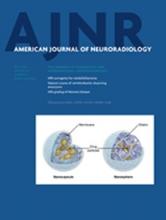Index by author
Kajiwara, I.
- FELLOWS' JOURNAL CLUBNeurointerventionYou have accessNatural Course of Dissecting Vertebrobasilar Artery Aneurysms without StrokeN. Kobayashi, Y. Murayama, I. Yuki, T. Ishibashi, M. Ebara, H. Arakawa, K. Irie, H. Takao, I. Kajiwara, K. Nishimura, K. Karagiozov and M. UrashimaAmerican Journal of Neuroradiology July 2014, 35 (7) 1371-1375; DOI: https://doi.org/10.3174/ajnr.A3873
More than 100 conservatively managed nonstroke dissecting vertebrobasilar artery aneurysms were followed on average for 3 years. Ninety-seven percent of patients remained clinically unchanged and the 3 patients who deteriorated clinically had aneurysm enlargement. The natural course of these lesions suggests that acute intervention is not always required and close follow-up without antithrombotic therapy is reasonable. Patients with symptoms due to mass effect or aneurysms of >10 mm may require treatment.
Kakimoto, N.
- Head & NeckYou have accessComparison of the T2 Relaxation Time of the Temporomandibular Joint Articular Disk between Patients with Temporomandibular Disorders and Asymptomatic VolunteersN. Kakimoto, H. Shimamoto, J. Chindasombatjaroen, T. Tsujimoto, S. Tomita, Y. Hasegawa, S. Murakami and S. FurukawaAmerican Journal of Neuroradiology July 2014, 35 (7) 1412-1417; DOI: https://doi.org/10.3174/ajnr.A3880
Kallmes, D.F.
- Head & NeckYou have accessImmunoglobulin G4–Related Disease of the Orbit: Imaging Features in 27 PatientsC.A. Tiegs-Heiden, L.J. Eckel, C.H. Hunt, F.E. Diehn, K.M. Schwartz, D.F. Kallmes, D.R. Salomão, T.E. Witzig and J.A. GarrityAmerican Journal of Neuroradiology July 2014, 35 (7) 1393-1397; DOI: https://doi.org/10.3174/ajnr.A3865
Karagiozov, K.
- FELLOWS' JOURNAL CLUBNeurointerventionYou have accessNatural Course of Dissecting Vertebrobasilar Artery Aneurysms without StrokeN. Kobayashi, Y. Murayama, I. Yuki, T. Ishibashi, M. Ebara, H. Arakawa, K. Irie, H. Takao, I. Kajiwara, K. Nishimura, K. Karagiozov and M. UrashimaAmerican Journal of Neuroradiology July 2014, 35 (7) 1371-1375; DOI: https://doi.org/10.3174/ajnr.A3873
More than 100 conservatively managed nonstroke dissecting vertebrobasilar artery aneurysms were followed on average for 3 years. Ninety-seven percent of patients remained clinically unchanged and the 3 patients who deteriorated clinically had aneurysm enlargement. The natural course of these lesions suggests that acute intervention is not always required and close follow-up without antithrombotic therapy is reasonable. Patients with symptoms due to mass effect or aneurysms of >10 mm may require treatment.
Kim, B.-j.
- BrainYou have accessDifferentiation of Tumor Progression from Pseudoprogression in Patients with Posttreatment Glioblastoma Using Multiparametric Histogram AnalysisJ. Cha, S.T. Kim, H.-J. Kim, B.-j. Kim, Y.K. Kim, J.Y. Lee, P. Jeon, K.H. Kim, D.-s. Kong and D.-H. NamAmerican Journal of Neuroradiology July 2014, 35 (7) 1309-1317; DOI: https://doi.org/10.3174/ajnr.A3876
Kim, H.
- FELLOWS' JOURNAL CLUBNeurointerventionOpen AccessInfluence of Patient Age on Angioarchitecture of Brain Arteriovenous MalformationsS.W. Hetts, D.L. Cooke, J. Nelson, N. Gupta, H. Fullerton, M.R. Amans, J.A. Narvid, P. Moftakhar, H. McSwain, C.F. Dowd, R.T. Higashida, V.V. Halbach, M.T. Lawton and H. KimAmerican Journal of Neuroradiology July 2014, 35 (7) 1376-1380; DOI: https://doi.org/10.3174/ajnr.A3886
Over 800 AVMs were retrospectively reviewed to determine if clinical and angioarchitectural features varied between children and adults. The authors found that hemorrhages and exclusively deep venous drainage were more common in children but high-risk features such as venous ectasia and feeding artery aneurysm were more common in adults. Thus, these latter high-risk features may take time to develop.
Kim, H.-J.
- BrainYou have accessDifferentiation of Tumor Progression from Pseudoprogression in Patients with Posttreatment Glioblastoma Using Multiparametric Histogram AnalysisJ. Cha, S.T. Kim, H.-J. Kim, B.-j. Kim, Y.K. Kim, J.Y. Lee, P. Jeon, K.H. Kim, D.-s. Kong and D.-H. NamAmerican Journal of Neuroradiology July 2014, 35 (7) 1309-1317; DOI: https://doi.org/10.3174/ajnr.A3876
Kim, K.H.
- BrainYou have accessDifferentiation of Tumor Progression from Pseudoprogression in Patients with Posttreatment Glioblastoma Using Multiparametric Histogram AnalysisJ. Cha, S.T. Kim, H.-J. Kim, B.-j. Kim, Y.K. Kim, J.Y. Lee, P. Jeon, K.H. Kim, D.-s. Kong and D.-H. NamAmerican Journal of Neuroradiology July 2014, 35 (7) 1309-1317; DOI: https://doi.org/10.3174/ajnr.A3876
Kim, S.T.
- BrainYou have accessDifferentiation of Tumor Progression from Pseudoprogression in Patients with Posttreatment Glioblastoma Using Multiparametric Histogram AnalysisJ. Cha, S.T. Kim, H.-J. Kim, B.-j. Kim, Y.K. Kim, J.Y. Lee, P. Jeon, K.H. Kim, D.-s. Kong and D.-H. NamAmerican Journal of Neuroradiology July 2014, 35 (7) 1309-1317; DOI: https://doi.org/10.3174/ajnr.A3876
Kim, Y.K.
- BrainYou have accessDifferentiation of Tumor Progression from Pseudoprogression in Patients with Posttreatment Glioblastoma Using Multiparametric Histogram AnalysisJ. Cha, S.T. Kim, H.-J. Kim, B.-j. Kim, Y.K. Kim, J.Y. Lee, P. Jeon, K.H. Kim, D.-s. Kong and D.-H. NamAmerican Journal of Neuroradiology July 2014, 35 (7) 1309-1317; DOI: https://doi.org/10.3174/ajnr.A3876








